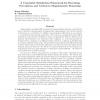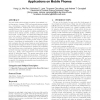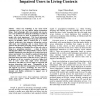500 search results - page 83 / 100 » Humans in the Process: Architectural Implications |
NIPS
2007
13 years 11 months ago
2007
The classical hypothesis, that bottom-up saliency is a center-surround process, is combined with a more recent hypothesis that all saliency decisions are optimal in a decision-the...
JAIR
2010
13 years 8 months ago
2010
Diagrammatic reasoning (DR) is pervasive in human problem solving as a powerful adjunct to symbolic reasoning based on language-like representations. The research reported in this...
MOBISYS
2009
ACM
14 years 10 months ago
2009
ACM
Top end mobile phones include a number of specialized (e.g., accelerometer, compass, GPS) and general purpose sensors (e.g., microphone, camera) that enable new people-centric sen...
JCIT
2007
13 years 10 months ago
2007
In this paper, we outline a framework for the development of natural language interfaces to agent systems with a focus on action representation. The architecture comprises a natur...
ICDS
2007
IEEE
14 years 4 months ago
2007
IEEE
- Smart care technology is any sensor based technology used to aid and support human independent living. Such technologies offer new potential and can give rise to new problems for...



